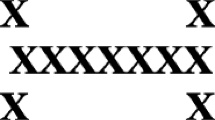Abstract
An advantage for trichromatic color vision in primates is shown by its presence in many lineages, but little attention has been paid to the potential disadvantages of trichromacy. Most New World monkey species are polymorphic for color vision, with both dichromats and trichromats present within a single population. We tested the foraging ability of trichromatic and dichromatic Geoffroy's marmosets (Callithrix geoffroyi) for colored cereal balls (Kix®) under conditions of red-green color camouflage (orange/green Kix® against an orange/green background) or lack of camouflage (Kix® same color as background) in a naturalized captive setting. In separate experiments designed to test foraging ability at long distances (<6 m) and short distances (<0.5 m), trichromats found significantly fewer Kix® under the camouflage condition than in the non-camouflage condition. In contrast, there is no difference in the ability of dichromats to detect color-camouflaged versus non-camouflaged Kix®. There is no significant difference between dichromats and trichromats for either camouflaged or non-camouflaged Kix®, though the power in the tests is low because of high individual variation. The results have clear implications for the foraging strategies of trichromatic marmosets. Differences in intensity of competition between trichromats and dichromats for items of food of different colors in relation to background may also have consequences for the foraging behavior of dichromats.
Similar content being viewed by others
References
Boissinot, S., Tan, Y., Shyue, S.-K., Schneider, H., Sampaio, I., Neiswanger, K., Hewett-Emmett, D., and Li, W.-H. (1998). Origins and antiquity of X-linked triallelic color vision systems in New World monkeys. Proc. Natl. Acad. Sci. U. S. A. 95: 13749-13754.
Caine, N. G. (1996). Foraging for animal prey by outdoor groups of Geoffroy's marmosets (Callithrix geoffroyi). Int. J. Primatol. 17: 933-945.
Caine, N. G. (2002). Seeing red: Consequences of individual differences in color vision in callitrichid primates. In Miller, L. E. (ed.), Eat or Be Eaten. Predation Sensitive Foraging Among Primates, Cambridge University Press, Cambridge, UK, pp. 58-73.
Caine, N. G., and Mundy, N. I. (2000). Demonstration of a foraging advantage for trichromatic marmosets (Callithrix geoffroyi) dependent on food color. Proc. R. Soc. Lond. B 267: 439-444.
Dominy, N. J., and Lucas, P. W. (2001). Ecological importance of trichromatic vision to primates. Nature 410: 363-366.
Hunt, D. M., Williams, A. J., Bowmaker, J. K., and Mollon, J. D. (1993). Structure and evolution of the polymorphic photopigment gene of the marmoset. Vision Res. 33: 147-154.
Jacobs, G. H. (1984). Within-species variations in visual capacity among squirrel monkeys (Saimiri sciureus): Color vision. Vision Res. 24: 1267-1277.
Jacobs, G. H., Neitz, J., and Crognale, M. (1987) Color vision polymorphism and its photopigment basis in a callitrichid monkey (Saguinus fuscicollis). Vision Res. 27: 2089-2100.
Jacobs, G. H., Neitz, M., Deegan, J. F., and Neitz, J. (1996). Trichromatic color vision in New World monkeys. Nature 382: 156-158.
Lucas, P. W., Darvell, B. W., Lee, P. K. D., Yuen, T. D. B., and Choong, M. F. (1998). Colour cues for leaf food selection by long-tailed macaques (Macaca fascicularis) with a new suggestion for the evolution of trichromatic color vision. Folia Primatol. 69: 139-152.
Mollon, J. D. (1991). Uses and evolutionary origins of primate color vision. In Cronly-Dillon, J. R., and Gregory, R. L. (Eds.), Evolution of the Eye and Visual System, CRC Press, Boca Raton, FL, pp. 306-319.
Mollon, J. D., Bowmaker, J. K., and Jacobs, G. H. (1984). Variations of color vision in a New World primate can be explained by polymorphism of retinal photopigments. Proc. R. Soc. Lond. B 222: 373-399.
Morgan, M. J., Adam, A., and Mollon, J. D. (1992). Dichromats detect color-camouflaged objects that are not detected by trichromats. Proc. R. Soc. Lond. B 248: 291-295.
Osorio, D., and Vorobyev, M. (1996). Colour vision as an adaptation to frugivory in primates. Proc. R. Soc. Lond. B 263: 593-599.
Regan, B. C., Julliot, C., Simmen, B., Vienot, F., Charles-Dominique, P., and Mollon, J. D. (1998). Frugivory and color vision in Alouatta seniculus, a trichromatic platyrrhine monkey. Vision Res. 38: 3321-3327.
Regan, B. C., Julliot, C., Simmen, B., Vienot, F., Charles-Dominique, P., and Mollon, J. D. (2001). Fruits, foliage, and the evolution of primate color vision. Phil. Trans. R. Soc. Lond. 356: 229-283.
Shyue, S.-K., Boissinot, S., Schneider, H., Sampaio, I., Schneider, M. P., Abee, C. R., Williams, L., Hewett-Emmett, D., Sperling, H. G., Cowing, J. A., Dulai, K. S., Hunt, D. M., and Li, W.-H. (1998). Molecular genetics of spectral tuning in New World Monkey color vision. J. Mol. Evol. 46: 697-702.
Shyue, S.-K., Hewett-Emmett, D., Sperling, H. G., Dulai, K. S., Hunt, D. M., Bowmaker, J. K., Mollon, J. D., and Li, W.-H. (1995). Adaptive evolution of color vision genes in higher primates. Science 269: 1265-1267.
Sumner, P., and Mollon, J. D. (2000a). Catarrhine photopigments are optimized for detecting targets against a foliage background. J. Exp. Biol. 203: 1963-1986.
Sumner, P., and Mollon, J. D. (2000b). Chromaticity as a signal of ripeness in fruits taken by primates. J. Exp. Biol. 203: 1987-2000.
Surridge, A. K., and Mundy, N. I. (2002). Trans-specific evolution of opsin alleles and the maintenance of trichromacy in Callitrichine primates. Mol. Ecol. 11: 2157-2169.
Surridge, A. K., Osorio, D., and Mundy, N. I. (2003) Evolution and selection of trichromatic vision in primates. Trends Ecol. Evol. 18: 198-205.
Tan, Y., and Li, W.-H. (1999). Trichromatic vision in prosimians. Nature 402: 36.
Tovée, M. J., Bowmaker, J. K., and Mollon, J. D. (1992). The relationship between cone pigments and behavioral sensitivity in a New World monkey (Callithrix jacchus jacchus). Vision Res. 32: 867-878.
Verhulst, S., and Maes, F. W. (1998) Scotopic vision in color-blinds. Vision Res. 38: 3387-3390.
Author information
Authors and Affiliations
Rights and permissions
About this article
Cite this article
Caine, N.G., Surridge, A.K. & Mundy, N.I. Dichromatic and Trichromatic Callithrix geoffroyi Differ in Relative Foraging Ability for Red-Green Color-Camouflaged and Non-camouflaged food. International Journal of Primatology 24, 1163–1175 (2003). https://doi.org/10.1023/B:IJOP.0000005985.18112.25
Issue Date:
DOI: https://doi.org/10.1023/B:IJOP.0000005985.18112.25




